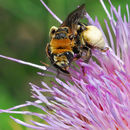Brief Summary
provided by EOL authors
Species in the genera Diadasia and Svastra are collectively called sunflower bees because, along with several other groups of plants, they are sunflower (Helianthus annuus) specialists. In addition to sunflowers, these bees specialize on mallows (Malvaceae), cacti (Cactaceae), evening primroses and willow herbs (Onagraceae), and wild bindweeds (Convolvulaceae). In fact, several cacti and mallows rely on sunflower bees for pollination services. These bees are found in the New World and most occur in the United States and Central America, although several species do occur in Canada. Svastra spp. are moderate to large sized bees, usually between 7.5 and 20 mm long. They are hairy with pale hair bands on their abdomen. Males have long antennae.
- license
- cc-publicdomain
- copyright
- National Biological Information Infrastructure (NBII) at http://www.nbii.gov
Life Cycle
provided by EOL authors
Most Svastra spp. are solitary ground-nesters. However, some species do nest communally with two or more queens sharing a nest and each queen individually building and provisioning her own brood cells. Each cell is provisioned with a nectar and pollen mixture and a single egg. Larvae hatch and turn into pupae. After a period of inactivity, adult bees emerge.
- license
- cc-publicdomain
- copyright
- National Biological Information Infrastructure (NBII) at http://www.nbii.gov
Pollinator
provided by EOL authors
Sunflower crops are typically planted in rows - pollen-producing male plants in one row, nectar-producing female plants in another. In order for pollination to occur, pollen must be moved from male plants to female plants by pollinators, primarily bees. Honey bees (Apis mellifera) are often used to pollinate sunflower crops, but worker honey bees specialize in either collecting pollen or nectar and primarily visit only one type of row. However, the presence of native bees, like sunflower bees, causes honey bees to change their foraging activity - the native bees chase the honey bees between the rows of sunflowers, making them up to five times more efficient pollinators, increasing seed set from three to 15 seeds produced per honey bee visit. In fact, research by Sarah S. Greenleaf and Claire Kremen has shown that the only sunflower fields to achieve 100% pollination are those fields with abundant native bee populations. The most important of these native bee species are long-horned (Melissodes spp.) and sunflower (Diadasia and Svastra spp.) bees. In this study, pollination by native bees accounted for only 7% of total pollination, but they were indirectly responsible for an additional 40% of pollination by alternating honey bee behavior.
- license
- cc-publicdomain
- copyright
- National Biological Information Infrastructure (NBII) at http://www.nbii.gov
Svastra: Brief Summary
provided by wikipedia EN
Svastra is a genus of long-horned bees in the family Apidae. There are at least 20 described species in Svastra.

Svastra texana
- license
- cc-by-sa-3.0
- copyright
- Wikipedia authors and editors


 Svastra texana
Svastra texana